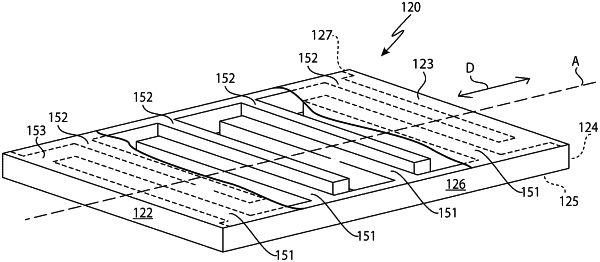| CPC H01M 10/0468 (2013.01) [H01M 10/0525 (2013.01); H01M 50/446 (2021.01); H01M 50/491 (2021.01); H01M 50/414 (2021.01); H01M 50/417 (2021.01); H01M 50/426 (2021.01); H01M 50/497 (2021.01); H01M 50/55 (2021.01); H01M 50/553 (2021.01); H01M 2004/021 (2013.01)] | 22 Claims |

|
1. A structure for use in an energy storage device, the structure comprising an electrode assembly and a constraint that maintains a pressure on the electrode assembly as the energy storage device is cycled between charged and discharged states,
the electrode assembly comprising a population of electrode structures, a population of counter-electrode structures and an electrically insulating separator material between members of the electrode and counter-electrode populations, wherein
the electrode assembly has opposing first and second longitudinal end surfaces separated along a longitudinal axis, and a lateral surface surrounding the longitudinal axis and connecting the first and second longitudinal end surfaces, the surface area of the first and second longitudinal end surfaces being less than 33% of the surface area of the electrode assembly,
members of the electrode population and members of the counter-electrode population are arranged in an alternating sequence in a stacking direction that parallels the longitudinal axis within the electrode assembly, and wherein each member of the electrode population has a bottom, a top, a length LE, a width WE, a height HE, and a central longitudinal axis AE extending from the bottom to the top of each such member and in a direction that is generally transverse to the stacking direction, the length LE of each member of the electrode population being measured in the direction of its central longitudinal axis AE, the width WE of each member of the electrode population being measured in the stacking direction, and the height HE of each member of the electrode population being measured in a direction that is perpendicular to the central longitudinal axis AE of each such member and to the stacking direction, the ratio of LE to each of WE and HE of each member of the electrode population being at least 5:1, respectively, the ratio of HE to WE for each member of the electrode population being between 0.4:1 and 1000:1, respectively, and
the constraint comprises first and second compression members that overlie first and second projected areas, respectively, wherein the first and second projected areas overlie the first and second longitudinal end surfaces, and at least one compression member that is internal to the longitudinal end surfaces, the compression members being connected by at least one tension member that overlies the lateral surface of the electrode assembly and pulls the first and second compression members toward each other.
|